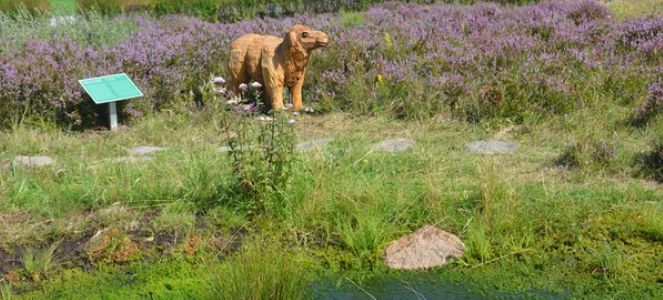DANISH HABITATS
Nature in pocket-sized plots
In the garden behind the Greenhouses, you can explore miniature versions of various Danish habitats, all of which occur naturally in East Jutland. While strolling through the habitats you can find facts and stories about plants and animals while enjoying a profusion of colours and scents. You may think these wild garden plots look untidy and overgrown, but that is precisely the point: to illustrate what a real habitat looks like, as opposed to a well-tended private garden. Here, in the heart of Aarhus, our outdoor Danish Habitats walk takes you on a natural tour of Denmark in less than an hour, giving you a taste of how diverse and fascinating nature is in this small country.
The plots in our Danish Habitats introduce you to:
Grassland and coastal slope
The term “grassland” denotes an open area with lots of light, and typically with many different species of grasses and flowering plants. Most grasslands in Denmark are the result of human activity. They are typically found in areas where the trees have been felled, and where the soil is poor and difficult to cultivate but still suitable as pasture. Grasslands are home to many flowers and grass species that benefit from the way grazing animals keep the taller competing plants bitten down. Some grasslands also have occasional thorny shrubs that the animals do not eat. In our miniature grassland plot the gardeners cut back the taller plants, since we have no live grazing animals in our habitats.
Grassland flowers include Bloody Cranesbill, Dwarf Everlast, and Purple-stem Cat’s-tail.
Beach and coastal meadow
The plants here adapt to the constant effects of wind, sand, salt, and waves. This means that many coastal plants can tolerate salt and have thick, succulent leaves. Often, they are also coated with a waxy layer that protects against strong sunlight and keeps them from drying out – like many of the desert plants in the Greenhouses’ indoor desert habitat.
Coastal vegetation includes Sea Sandwort, Sea Kale and Lyme Grass.
Heath
The heath is dominated by small dwarf shrubs such as heather and crowberry, and it is found where the soil is sandy and nutrient poor. Like Danish grasslands, the heath is also a result of human activity, arising where the forest has been felled. In areas where the soil was too poor to cultivate, heather has spread to cover the ground. In former times peasants used to let their domestic animals, especially sheep, graze on the heath, and they also cut heather to use as bedding for livestock and fuel for the fireplace. Nowadays heath areas must be maintained with grazing programmes and controlled burning of the vegetation, both of which prevent spontaneous reforestation. Our gardeners maintain the heath plot in our Danish Habitats by weeding out unwanted plants.
Plants found on the heath include Common Heather, Bell Heather and Lingonberry.
Meadow
Meadows are typically found in low-lying, wet tracts of land. In former times, bogs and meadows made up a large part of Denmark’s surface area. Although too wet to cultivate, such areas were important to farmers, who let livestock graze there and also cut the tall meadow grasses to make hay. To maintain a meadow the vegetation must either be cut for hay or grazed down by livestock, thereby preventing the flowering perennial plants from taking over. Butterflies and other insects benefit from the meadow’s many flowers, and during spring and summer our miniature meadow is teeming with butterflies.
Meadow plants include Common Buttercup, Ragged Robin and Broad-leaved Marsh Orchid.
Grain fields
More than 60% of Denmark’s land area is cultivated, and agriculture has played an important role throughout Danish history. Each year visitors can come and watch the miniature grain fields as the seeds are sown, grow, mature, and are ultimately harvested in August. The most common cereal grains in Denmark are wheat, barley, rye and oats.
Deciduous forest
One third of the woodlands in Denmark consist of deciduous trees (as opposed to evergreens). Our little forest has several species, including beach, oak, and alder. In early spring the blooms of Wood Anemone carpet the forest floor – giving these flowers a head start before the beech leaves in the greening canopy take the light.
Common trees in Danish forests include beech, birch and oak.

